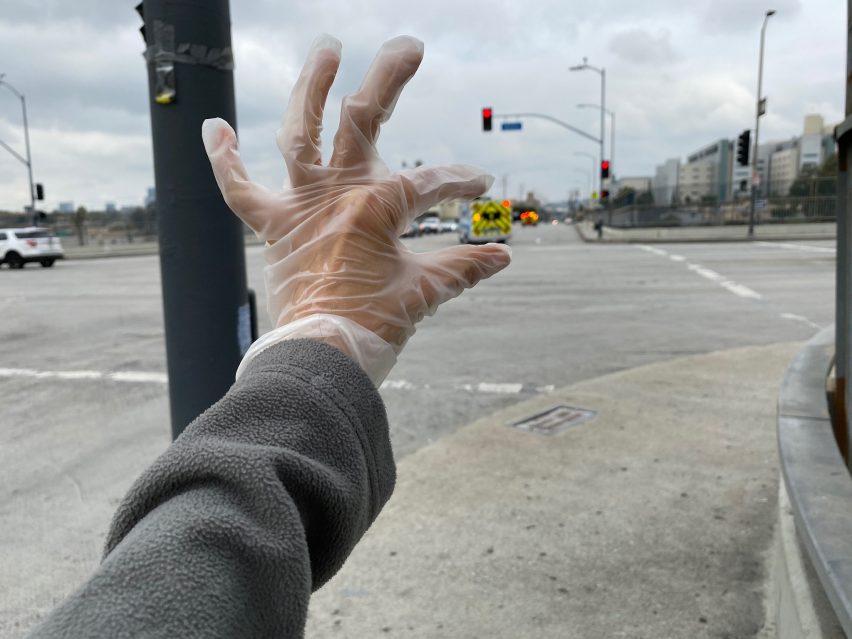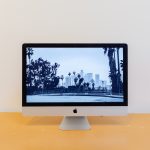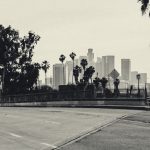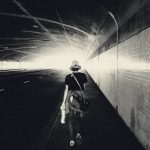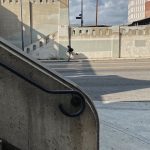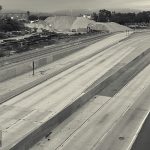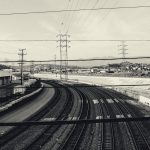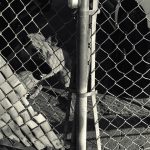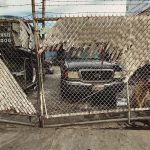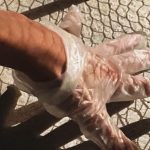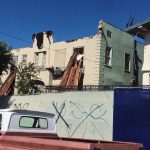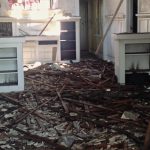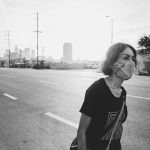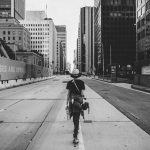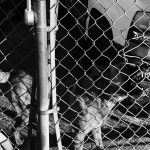Last Light
About the Piece
The component of Hand Dog Glove produced by Clockshop is a short film, Last Light, made immediately prior to and during the first wave of the pandemic. Last Light is a meditation on walking and memory in Los Angeles. The film explores notions of selfhood under the dual threat of contagion and isolation. Combining video and still images of an evacuated city with an intimate voiceover, the narrator reflects on feelings of vulnerability and betrayal, and draws on childhood memories to makes sense of a city transformed. Over the course of the piece, day moves to night as the artist traces a path from demolition and sickness to envisioning a different world.
Directed by Carmen Argote
Edited by Aldo Velasco
Sound design & Composition by Johnny Wilson
Camera & Still photography by Carmen Argote and Gina Clyne
Produced by Clockshop
Interview with Carmen Argote
Artist Carmen Argote talks about walking the streets of Los Angeles and the development of her new work with Clockshop in the time of Covid-19. We’ve been working with Carmen for almost two years, developing ideas and raising funds. In that time Argote’s project has shifted from a multi-week residency at the Bowtie to her first short film. Below she chats with us about collective sickness, her process of work and the body as studio.
First, how are you holding up during Covid-19?
The short answer would be, I survived.
The long answer is that, like many others, the Covid-19 pandemic started for me with the cancelation of scheduled shows, art fairs, and workshops. Our pandemic induced distancing also coincided with me needing to be hospitalized for something non-Covid-19 related that could have killed me.
I think of this question as having a shape like a quartz—the ones you hang around your neck. I was thinking that I actually don’t have the language to express what I feel in this moment. “I hope you are safe and well,” is not working anymore. In one way, the Covid-19 pandemic opens up a way of living that I had been seeking and trying to enact in my practice through the slowness of walking. Being able to see the sun in the middle of the day, had become a priority, as that seemed more like success than having a steady full time job. There are no words to express that you don’t want a job but love to work. This feeling had not been possible to experience collectively because of the structure of capitalism and its usage of our time in exchange for money. We were always for sale. The deconstruction and reconstruction of how we use our time in contrast to notions of productivity has shifted. It feels like a demolition with many sides—some are pro and some are con.
How has this time changed or affected your art practice?
Since December 2019, I had been living with Cynthia, in what I would describe as an artist-in-residence in her apartment. The focus was on our collaborative healing. Cynthia started a gallery called Stairwell Los Angeles at the Francis, a family quadruplex in Westlake.
I began using the domestic space as a studio. I had a nice bed, and good food. We started organizing my finances, and conversed about our mental health, and what we wanted for ourselves. Artistic ideas were very much also a part of this, but the focus was on learning. A learning process about how to live more financially and mentally independently, and how to do this within a system that is designed to keep you in need. It was a workshop on how to navigate capitalism and stay in one’s own humanity and gratitude.
These past two years, I have made work in different parts of the world. It has been a re-learning of my own patterns of living. I’ve learned to follow and trust a guttural feeling of knowing. Walking and thinking with my body in motion have worked as a way to open up that space for ideas to enter. Time without intention, other than to just walk, and allow for it to be, is the most important material. I make the work, then I leave it. My practice stays with me.
I feel a need to make art now, I actually can’t stop because I feel an immediacy in the experience of a shared sickness. I don’t need to suffer, and I don’t need to ignore my basic needs, to thrive artistically. That is what Covid-19, and having this time to reflect, has taught me about maintaining and living within my art practice.
Your project has undergone so many changes over the time we have been working together. What has the process of working with Clockshop been like for you? Tell us!
In my recent residencies and projects, the turnarounds were a month, sometimes less. This way of working requires a sort of frantic searching. Having the opportunity to work with Clockshop, with a much longer time frame, has allowed me to develop the work with a calmer state of mind that is equally as vulnerable. I feel empowered to take on psychological aspects within the work in a more collaborative way. I feel a greater sense of collaborative trust. The construction and deconstruction of all these previous ideas of artwork, along with this extended timeline in the conceptualizing of the work, has put me in a stronger mental state.
I can be in my vulnerability and still be of enough sound mind to not derail myself in the little death that is art making.
You often take long walks as part of your practice. What are your walks through the city like these days? Can you describe them?
The Covid-19 pandemic has changed the way I navigate public space, and it has changed how I see things. I found myself thinking of the gas station store as a market, and avoiding familiar routes that would have me walking near hospitals.
I notice that in order to avoid other people on the sidewalk, I will walk onto the street, and often cross in a diagonal. I find myself complaining to myself about people being in my way, not wearing masks etc. A sort of volatile thing inside comes out.
These movements are a navigation around a potential threat. The air around me is filled with helicopter sounds, sirens, birds and dogs barking. Motorcyclists and fast cars roar, and I seem to be more invisible than ever as a pedestrian at a crosswalk. I get asked if I want a ride a lot more frequently. I use my foot to press the crosswalk button. At night, I feel more of that dangerous feeling, mostly because I feel a growing tension between pedestrians. I am not walking a dog, I am not on my way to the supermarket and I’m not a jogger. I saw a rock on the sidewalk and I thought about it as a potential weapon someone could use to bash my head and take my phone.
Downtown Los Angeles feels like a video game, the escalators are empty and loud. There are no restrooms, so I use the park. Time feels very abstract and random. In my most recent walk in Downtown, I just got the sense of the interior space and the exterior, the public and the private, blurring into each other.
Because being out at the Bowtie is not possible at this moment, you have shifted your project to a short film. What does it feel like to work in a new medium? Is it scary or exciting or both?
Shifting to film seems ideal because the current situation is so psychological. The gathering of materials is shaping the work and that is very exciting for me. I want to know what is going to come forward, the gathering begins to reveal and converse with my own experiences. In many ways, the artistic process is the same. The main difference I feel is that usually, the subject being used as the vehicle for the narrative is not me so directly. Here, I have to remember to turn the video and audio onto myself. It makes total sense, but that process is new. This is actually a great time to work with a medium as psychological as film. The city is the material and my body is the studio. Hopefully I don’t get demolished.
Carmen Argote (b. 1981, Guadalajara, Mexico; lives and works in Los Angeles) received her MFA in 2007 from the University of California, Los Angeles, where she also received her BFA in 2004. Recent solo exhibitions have been held at Visual Arts Center, University of Texas, Austin (2020); New Museum, New York (2019); PAOS, Guadalajara, Mexico (2019); Ballon Rouge Collective, Istanbul, Turkey (2019) and New York (2018). Argote has been featured in group exhibitions at SculptureCenter, New York (2019); Hammer Museum, Los Angeles (2018); Ballroom Marfa (2017); and Denver Art Museum (2017). She is the recipient of the Artadia Los Angeles award (2019), Artist Community Engagement Grant from the Rema Hort Mann Foundation (2015) and a California Community Foundation Fellowship for Visual Artists (2013). Argote is represented by Commonwealth and Council, Los Angeles, CA.
Support for this project is provided by the National Endowment for the Arts, the Los Angeles County Arts Commission, the Pasadena Art Alliance, and the Andy Warhol Foundation for the Visual Arts.
Pasadena Arts Alliance The Andy Warhol Foundation for the Visual Arts
Material: digital film. 12 minutes
Dimensions: edition of 5 with 2 AP
